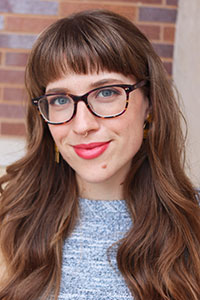For Elizabeth Haynes, a cell biologist and Morgridge Postdoctoral Research Fellow, microscopy is where it all comes together.
Not only does the technology allow researchers to peer into the many layers of life itself, but often the images are beautiful (and she would know, having won first place in the 2018 Nikon Small World in Motion Competition with Henry He, an alumnus of the Jan Huisken Lab).
“It’s kind of impossible to not fall in love with microscopy because it’s art and science together. It’s so compelling,” she says.
In August, Haynes joined the Kevin Eliceiri Lab in biomedical imaging at the Morgridge Institute, kicking off a three-year fellowship in collaboration with Tyler Ulland, a professor in the department of Pathology and Laboratory Medicine at UW–Madison.

She hopes to better understand the role of microglia, a type of immune cell in our central nervous system, by capturing how these cells work in Alzheimer’s disease, particularly how the early disease progresses.
Haynes is long on biological experience. She received her Ph.D. in cell and developmental biology at the University of North Carolina before joining the lab of Mary Halloran, a professor in integrative biology at UW–Madison, for her first postdoctoral research position. There, Haynes specialized in understanding the cellular mechanisms that underlie neurodegenerative diseases through advanced genetic and live imaging approaches in zebrafish.
Zebrafish, especially the crystal-clear Casper strain, are something of an in vivo imaging darling. The quick-growing animals are optically clear so scientists can use imaging to inspect the brains for disease.
Haynes’ time in the Halloran Lab ultimately resulted in a zebrafish model for a poorly understood neurodegenerative disease and led her to another idea: The fish may be an ideal model to understanding Alzheimer’s disease, a progressive neurodegenerative disease that impacts more than 3 million people annually in the United States.
But researching Alzheimer’s disease is challenging.
For starters, it’s difficult to work with tissue because the samples are collected after death. And if you’re trying to understand early illness, like Haynes, such tissue samples aren’t particularly helpful since it often reflects an advanced stage of the disease.
“I often refer to myself as a translator. I knew that I wanted to be someone who maybe isn’t fully a biologist, and isn’t fully an image analysis or microscopy development person, but someone who is comfortable having one foot in each area.”
Elizabeth Haynes
In other methods, such as in the mouse model, a cranial window can be installed to study the brain, but it’s a technical, expensive, and time-intensive process. That technique also doesn’t work in Haynes’s planned line of research — the procedure could kickstart inflammation (an immune response) which is the exact area she’s trying to study in Alzheimer’s disease progression.
“I often refer to myself as a translator,” say Haynes, because she can readily move between biology and imaging domains. “I knew that I wanted to be someone who maybe isn’t fully a biologist, and isn’t fully an image analysis or microscopy development person, but someone who is comfortable having one foot in each area.”
Haynes was always interested in science and technology as a child growing up in Florida. She tinkered with soldering and circuits. Computers and programming languages fascinated her. But Haynes’s path into science was crystalized as a teen. She realized that coding for computers had a direct parallel to biology – DNA, the code for organisms, could be re-programmed in cells.
Over the next year, Haynes hopes to create a model zebrafish for Alzheimer’s by introducing mutations in genes that lead to development of the tell-tale plaques of the disease.
“Liz is exactly the type of cross-domain scientist that is needed to bring new imaging and animal models to Alzheimer’s disease,” says Eliceiri. “This line of research needs a scientist like Liz who is committed to investing time in both the imaging and biological components.”
Using noninvasive light sheet imaging, Haynes hopes to serially record the zebrafish over time. That may allow her to link up physiological behavior — e.g., changes in cognition and response — to the imaging itself.
“That’s really the thing that makes this research stand out from all the other work that’s being done — it’s not invasive,” she says. “We can look at the progress of the same animal and we can do it on a much larger scale. So then, once we have this model established, you can ask questions like, ‘Do we want to do a drug screen? Do we want to treat all these fish with different drugs and say, which ones show cognitive improvement?’”
“There is a great opportunity to improve our knowledge of Alzheimer’s disease, particularly early onset. I believe the tools and data that Liz will generate in this multidisciplinary collaboration will greatly aid in future research,” adds Eliceiri.
Haynes, who is also excited about what’s next, has jumped into the optical imaging world at Morgridge and across UW–Madison through her fellowship.
“You immediately are brought into this community to help you achieve your goals,” Haynes said about her Morgridge fellowship. “It’s very supportive and goal-oriented. And then on top of that, it’s really about your personal development and growing as a researcher.”
